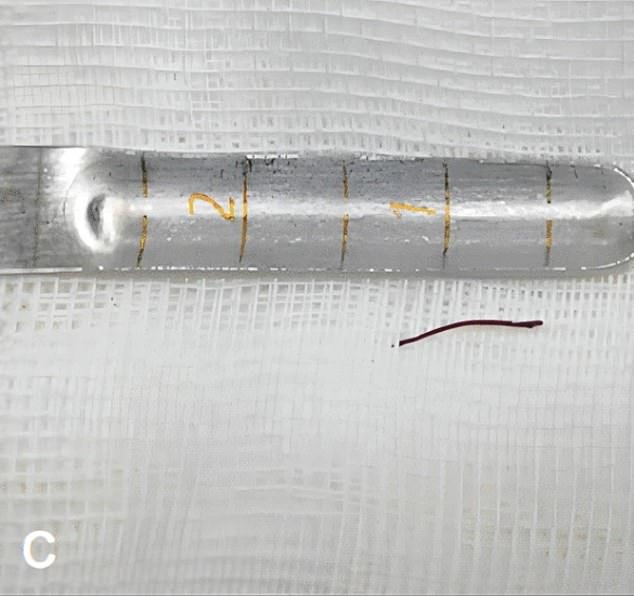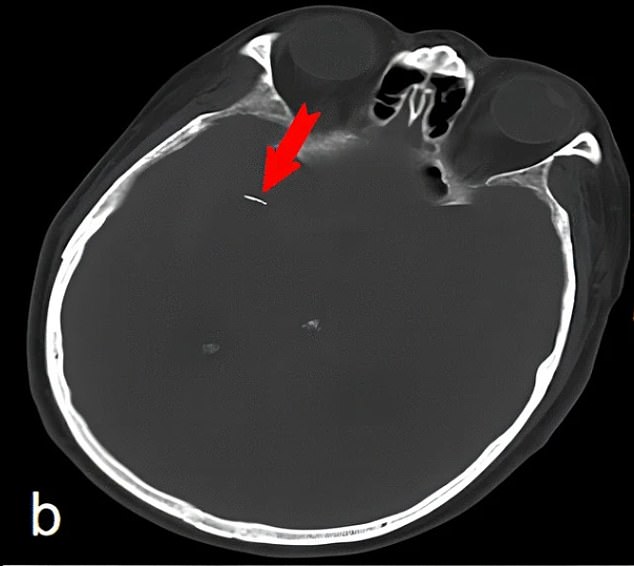A patient who thought he was suffering from an aneurysm was found to have an acupuncture needle embedded inside his brain.
Scans revealed the half-inch-long, “golden-colored” and “slightly pointed” needle lodged inside an artery inside the 74-year-old’s brain.
It was causing internal bleeding that was leaving him with memory problems, which rushed him to the hospital.
His family said the needle had probably been there for two decades because they only remembered that he had undergone acupuncture in the early 2000s for a persistent migraine.
The needle was removed through surgery that involved opening the skull. The man, from Sichuan, China, survived but died three weeks later after suffering a lung infection.
This 74-year-old man from Sichuan, China, went to the doctor with an acupuncture needle embedded in his brain behind his right eye (pictured). This view shows the bottom of the skull that has been turned so that the needle appears on the left side.

The photo above shows the part of the acupuncture needle that was removed during surgery. The family said it had been lodged in his brain for two decades.
Acupuncture is a traditional Chinese medical practice that involves inserting hundreds of small needles into specific points on the body to stimulate energy, known as qi, pronounced “chee.”
Acupuncturists say the method can help relieve pain, reduce stress and even aid joint recovery by helping to stimulate nerves and blood flow in the areas receiving treatment.
But the scientific evidence on the method is inconclusive, and only a few studies suggest that acupuncture benefits patients.
The small needle inside the man was found in an artery that runs through the brain behind the right eye, called the right middle cerebral artery.
It was suggested that the needle may have broken during an acupuncture treatment and then been carried into the artery behind the eye.
It was not clear what caused the break, but this could be related to a fall, a strong impact to the head or due to the needle’s position changing in the skull.
The man was rushed to the doctor within an hour after his memory problems emerged, and the family initially feared he suffered an aneurysm.
But scans revealed the needle in his brain and bleeding.
To remove the needle, doctors first had to cut a portion of his skull (in a procedure called craniotomy) to access his brain.
They then cut away the dura mater, or the thick outer layer of the brain, and used a surgical microscope to navigate through the brain to the needle, avoiding vital arteries and structures.
The needle was then removed and the broken blood vessel was closed using a very small metal clip to close the broken part of the vessel.
After surgery, the man initially recovered well and was taken off the ventilator ten days later.
But he then developed a lung infection while in hospital and died three weeks after surgery.
Doctors said the infection may have been related to his loss of consciousness during the operation, which turns off the body’s natural defenses against lung infections such as coughing or the gag reflex.
Doctors diagnosed the man with an intracranial pseudoaneurysm, which occurs when blood leaks from a vessel in the brain but is held in place by surrounding tissue.
They differ from a true aneurysm, which occurs when the wall of a vessel weakens and swells as blood pools inside.
Pseudoaneurysms are extremely rare and account for less than five percent of all arterial punctures.
Doctors said this case was the first recorded in medical literature of a man who suffered a pseudoaneurysm caused by an acupuncture needle.
Previous cases have been caused by infections that damage arteries in the brain, as well as head trauma or sudden impacts to the head.
The case was revealed in Medical Case Report Magazine.
In the article led by Dr. Qiang Li, a neurosurgeon at the Hospital of Southwest China Medical University, the authors said: “Foreign body-induced intracranial pseudoaneurysms represent a difficult and rare entity… requiring diagnosis and intervention rapid”.
“The rarity of these events underscores the critical importance of maintaining a high index of suspicion, particularly in cases involving recent medical trauma or craniocerebral injuries.”


